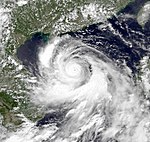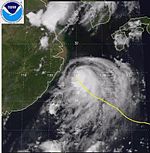1989 Pacific typhoon season
| 1989 Pacific typhoon season |

Season summary map
|
| Seasonal boundaries |
| First system formed |
January 15, 1989 |
| Last system dissipated |
December 27, 1989 |
| Strongest storm |
|
| Name |
Gordon and Elsie
|
| • Maximum winds |
185 km/h (115 mph) |
| • Lowest pressure |
915 hPa (mbar) |
| Seasonal statistics |
| Total depressions |
42 |
| Total storms |
32 official, 2 unofficial |
| Typhoons |
20 official, 1 unofficial |
| Super typhoons |
5 (unofficial) |
| Total fatalities |
At least 3,459 total |
| Total damage |
$2.1 billion (1989 USD) |
| Related articles |
|
|
Pacific typhoon seasons
1987, 1988, 1989, 1990, 1991
|
| Tropical storm (JMA) |
| Tropical storm (SSHWS) |
|
|
| Duration |
January 15 (Entered basin) – January 21 |
| Peak intensity |
65 km/h (40 mph) (10-min) 991 hPa (mbar) |
| Typhoon (JMA) |
| Category 5 super typhoon (SSHWS) |
|
|
| Duration |
April 17 – April 24 |
| Peak intensity |
185 km/h (115 mph) (10-min) 920 hPa (mbar) |
| Typhoon (JMA) |
| Category 1 typhoon (SSHWS) |
|
|
| Duration |
May 14 – May 21 |
| Peak intensity |
120 km/h (75 mph) (10-min) 970 hPa (mbar) |
| Severe tropical storm (JMA) |
| Category 1 typhoon (SSHWS) |
|
|
| Duration |
May 22 – May 26 |
| Peak intensity |
110 km/h (70 mph) (10-min) 975 hPa (mbar) |
| Typhoon (JMA) |
| Category 3 typhoon (SSHWS) |
|
|
| Duration |
June 4 – June 12 |
| Peak intensity |
150 km/h (90 mph) (10-min) 955 hPa (mbar) |
| Severe tropical storm (JMA) |
| Tropical storm (SSHWS) |
|
|
| Duration |
June 18 – June 24 |
| Peak intensity |
95 km/h (60 mph) (10-min) 985 hPa (mbar) |
| Severe tropical storm (JMA) |
| Tropical storm (SSHWS) |
|
|
| Duration |
July 6 – July 11 |
| Peak intensity |
100 km/h (65 mph) (10-min) 980 hPa (mbar) |
| Typhoon (JMA) |
| Category 5 super typhoon (SSHWS) |
|
|
| Duration |
July 9 – July 19 |
| Peak intensity |
185 km/h (115 mph) (10-min) 915 hPa (mbar) |
| Tropical storm (JMA) |
| Tropical storm (SSHWS) |
|
|
| Duration |
July 16 – July 21 |
| Peak intensity |
85 km/h (50 mph) (10-min) 990 hPa (mbar) |
The 1989 Pacific typhoon season has no official bounds; it ran year-round in 1989, but most tropical cyclones tend to form in the northwestern Pacific Ocean between May and November. These dates conventionally delimit the period of each year when most tropical cyclones form in the northwestern Pacific Ocean. Tropical Storms forming in the Western Pacific basin were assigned a name by the Joint Typhoon Warning Center. Tropical depressions that enter or form in the Philippine area of responsibility are assigned a name by the Philippine Atmospheric, Geophysical and Astronomical Services Administration or PAGASA. This can often result in the same storm having two names.
Throughout 1989, several large-scale factors across the western Pacific Ocean displaced unusual characteristics that presented unique difficulties to forecasters. In their annual tropical cyclone report for 1989, the Joint Typhoon Warning Center regarded the season as one of the most challenging and unique years in their history. During much of the year, a very broad monsoon trough was present and resulted in significant diurnal fluctuations in convective activity that inhibited rapid development of many disturbances. The mid-tropospheric ridge was unusually narrow and led to difficulties in forecasting straight-running storms. Additionally, the Tropical Upper Tropospheric Trough (TUTT) had a major role in the development of many systems, most notably Typhoon Gordon which formed from a single thunderstorm underneath a TUTT cell.
The season began with the unusual development of Tropical Storm Winona east of the International Dateline in early January. Remaining active for two weeks, the system crossed the basin before dissipating over the Philippines. Following a three-month lull in activity, a powerful typhoon developed in mid-April and was the second system in nine years to become a super typhoon during that month. By mid-May, an extensive monsoon trough had become established from the Bay of Bengal eastward into the South China Sea. Typhoon Brenda developed from this trough over the South China Sea and moved inland over southern China before dissipating. The typhoon left an area of enhanced low-level southerly flow in its wake that triggered the development of Typhoon Cecil at the end of the month. Two more storms developed during June – Typhoon Dot and Tropical Storm Ellis. The first was a strong typhoon that developed near the Caroline Islands and moved westward, eventually dissipating over Vietnam. The second was a poorly organized system that moved generally northward and struck Japan.
...
Wikipedia



















